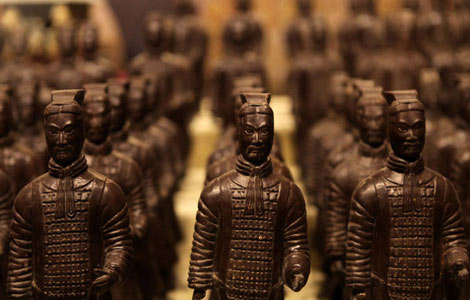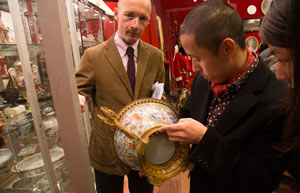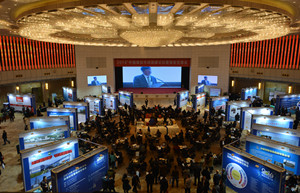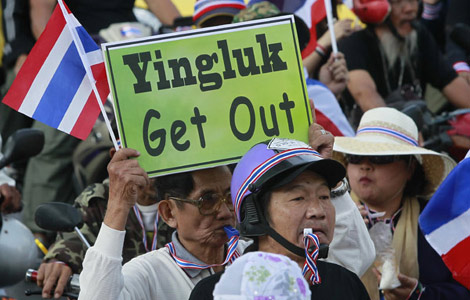When aesthetics bring two together
By Alicia Liu ( China Daily Europe ) Updated: 2013-12-20 10:00:41Art can be the shared common ground for Europe and China
Though there is a world of difference between Europeans and Chinese, there are some common threads that they share, like the appreciation of history, civilization and artistic tradition.
The common links have been aptly summed up by Winston Churchill, the late British prime minister, when he said, "Those who fail to learn from history are doomed to repeat it."
China's claim to be the oldest and most continuous civilization often finds credence in its rich artistic traditions that stretch uninterrupted from the Neolithic era to the present. Modern day Chinese, amid all the glamour associated with social transformation, are looking for a coherent set of values derived from the diversity and richness of their history, as well as the traditions and aesthetic values embodied in Chinese arts.
The phenomenal interest in Chinese art and antiques that is being seen in Europe is a reflection of this soul-searching process.
There are two conditions that need to be met to sustain the Chinese interest in buying art. One is appreciating culture; and the other is having the financial means to afford it.
Chinese investment in the UK is now at an unprecedented high level, ranging from state-backed infrastructure investment to purchases by wealthy individuals. The opportunity to exploit this economic capital seems to be recognized, with many auction houses and antique dealers investing in Chinese-language signs and prominently displaying the UnionPay logo in their shop windows.
However, on closer inspection, you will find that these establishments tend to hold a welcoming but cautious attitude toward newcomers. For them, credibility established through the reputation built up over the years is the most important calling card for the trade, even more important than new-found wealth.
In a highly regulated market, the boldness of adapting to the change of new customers relies on cautious and intelligent execution. People are likely to start with an area that they feel comfortable and familiar with, perhaps a place of higher transparency in business regulations.
Take Asian Art in London, an annual London city-wide antique art fair, as an example. Its bilingual marketing collateral this year is in traditional Chinese rather than the simplified Chinese commonly used in the Chinese mainland.
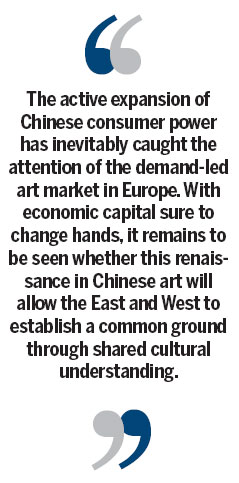
Royalty and celebrity collectors often flock to the Masterpiece London, an art, antiques, design fair held at the Chelsea Royal Hospital in summer. This year a Hong Kong Pavilion was held at the fair, organized in partnership with Fine Art Asia, one of the largest Asian fine art fairs based in Hong Kong.
All of these seem to be sending mixed signals to Chinese buyers. On one level they recognize the rise in interest in Chinese antiquities and an increase in the wealth of Chinese collectors; however, they continue to use more familiar territories such as Hong Kong as a conduit to the mainland.
The Chinese elites are often drawn to Europe by the respect for authenticity and diligence when conducting business. They are drawn to spend some of their newly earned economic capital in exchange for cultural capital in the form of art.
Some of them may even hope to understand the history of their past through the artwork, in the hope that by understanding the past, they will be able to better appreciate where they are going.
However, it is not only the Chinese who have developed a newfound love for the tradition and innovation demonstrated in many of these works. Their European counterparts continue to demonstrate a strong interest in Chinese historical pieces. The current V&A exhibition "Masterpieces of Chinese painting 700-1900" has been received warmly in the UK, with many struggling to secure tickets for the show.
Some of the Chinese traditional values illustrated through the paintings are surprisingly similar to the pursuits of British gentleman; for example the leisure activities in pursuit of happiness during prosperous times.
The paintings also depict the notion of embracing solitude to move away from materialist temptations. This carries a striking similarity with moral views held in the Victorian era some 300 years ago.
For many Chinese, the traditional Chinese artworks hold more than just financial value. They embody a set of philosophical, symbolic and historical values that are shared by the nation. It is as if audiences in the East and West have found a common ground, a shared social value through the appreciation of traditional Chinese artists.
The active expansion of Chinese consumer power has inevitably caught the attention of the demand-led art market in Europe. With economic capital sure to change hands, it remains to be seen whether this renaissance in Chinese art will allow the East and West to establish a common ground through shared cultural understanding.
The author is director of Singing Grass Communications, an agency bridging the East and the West through arts and culture.
( China Daily European Weekly 12/20/2013 page9)
|
|
|
|
|
|
|
|
European Weekly
 China taken on as building partner
China taken on as building partner
Meetings with central and Eastern European heads underline China's global roal.



